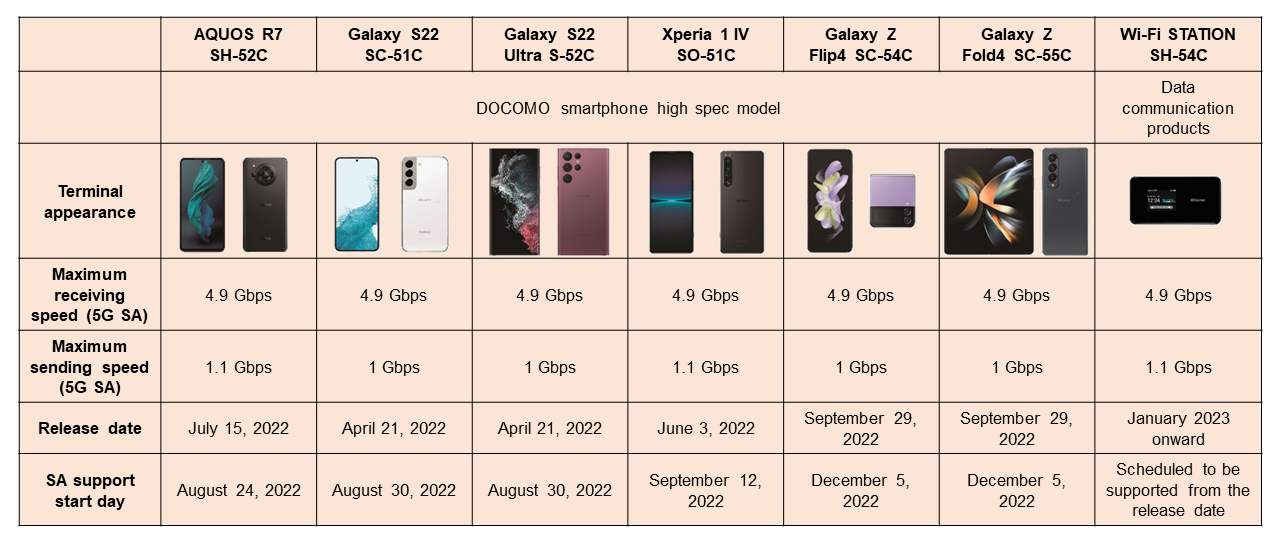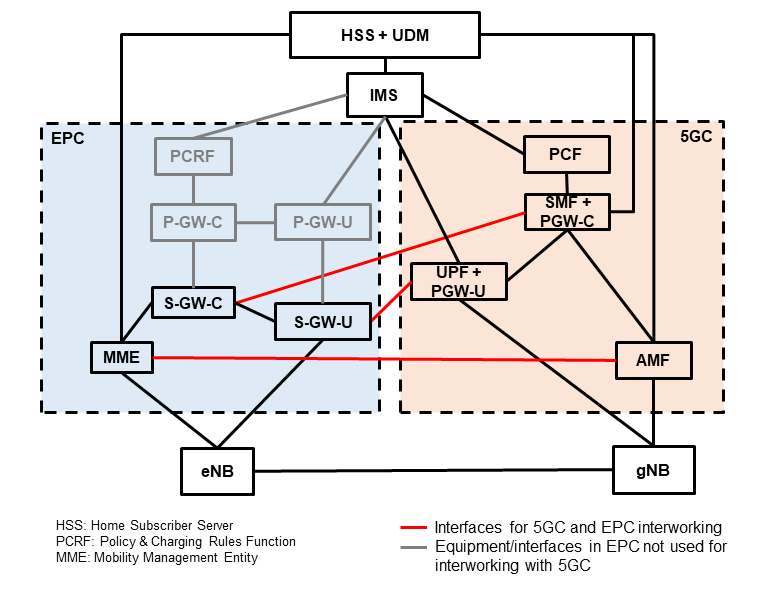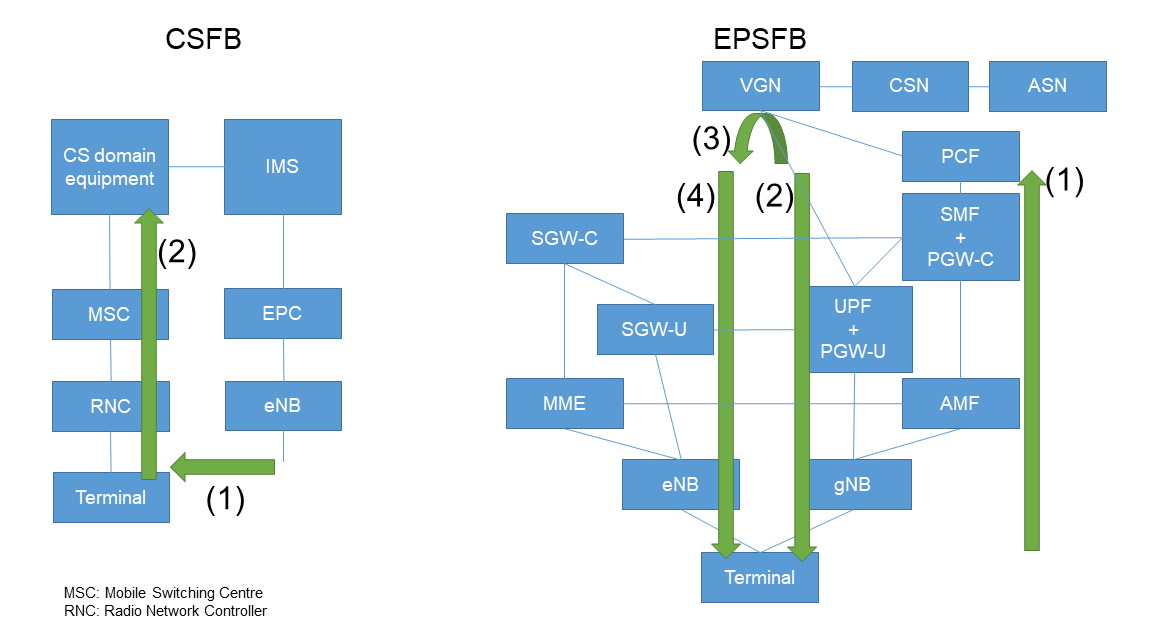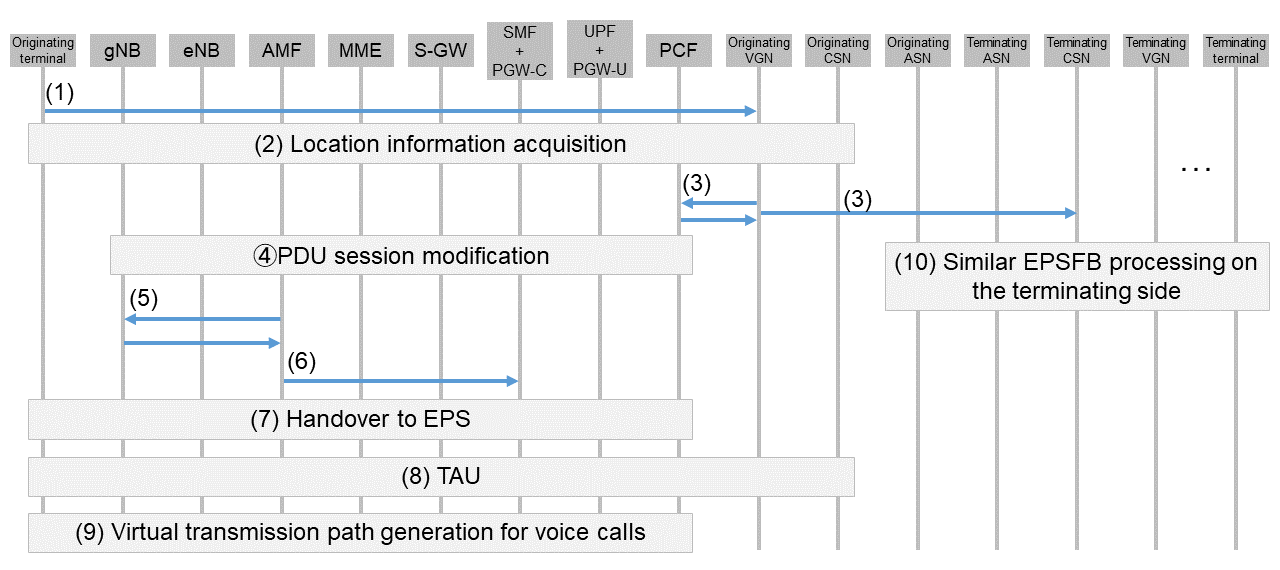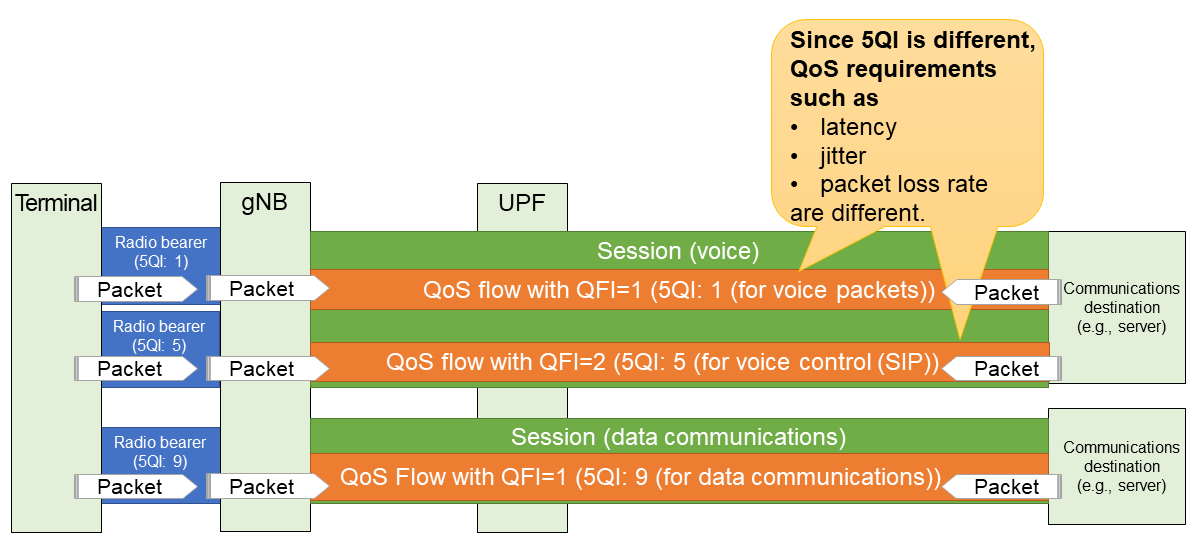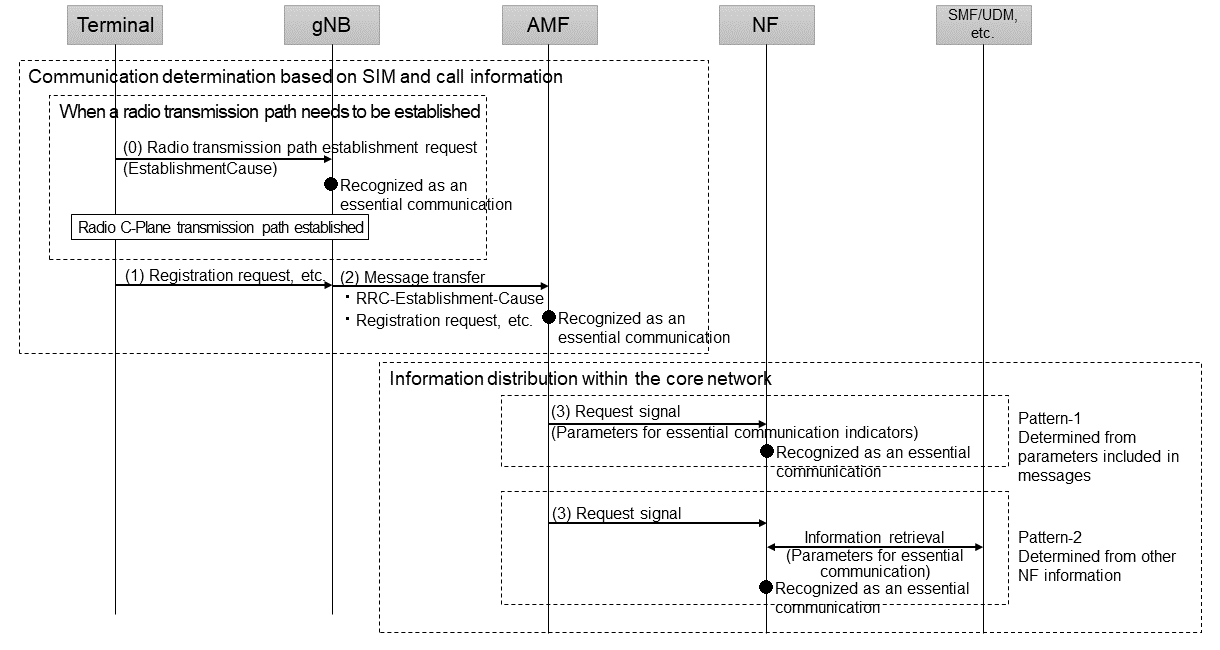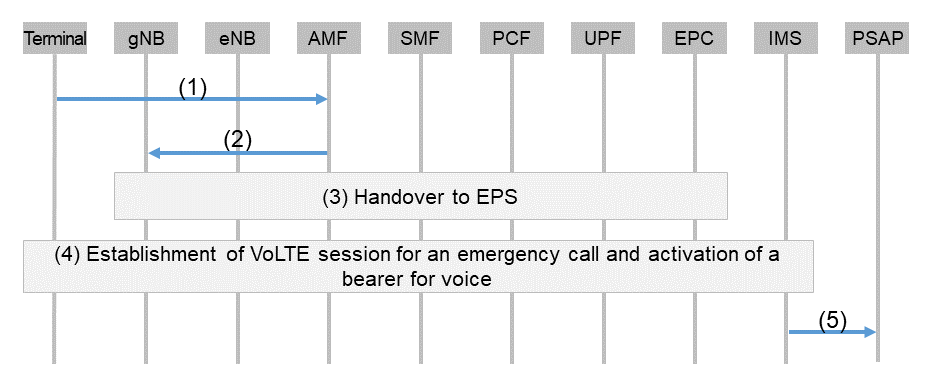Special Articles on 5G SA
Overview of Core Network Technologies for Voice Calls with 5G Standalone
5GC EPSFB Priority Control
Kazuto Shimizu, Motohiro Abe, Yuya Miyazaki and Hiroki Ohara
Core Network Development Department
Abstract
In August 2022, NTT DOCOMO launched a new 5G service with the 5G Standalone deployment model. To provide this service, NTT DOCOMO has introduced new functions to its core network to enable voice call services for 5G SA users. This article describes these new functions and related technologies.
01. Introduction
-
In August 2022, NTT DOCOMO launched a new 5G service for ...
Open

In August 2022, NTT DOCOMO launched a new 5G service for smartphones with the 5th generation radio access with standalone deployment model, the so-called 5G Standalone (SA)*1. NTT DOCOMO plans to offer a total of seven 5G SA-compatible models in FY2022: six smartphones and one Wi-Fi router (Figure 1). All models use a simultaneous radio communications technology called New Radio Dual Connectivity (NR-DC)*2, which improves the maximum throughput rate compared to 5G Non-Standalone (NSA)*3.
Two conditions below have to be fulfilled to provide 5G SA for smartphones.
- Areas: 4G Long-Term Evolution (LTE)/5G NSA areas have to be provided until 5G SA areas are sufficiently expanded to cover those areas.
- Features: Voice call services, including emergency calls, must be provided.
To fulfill these conditions, NTT DOCOMO has introduced the following three functions to the 5G Core network (5GC)*4.
- Interworking with Evolved Packet Core (EPC)*5 for mobility between 4G area and 5G areas.
- Evolved Packet System*6 FallBack (EPSFB) and adaptive Quality of Service functionalities for voice calls in 5GC*7
- Priority control of critical communications and emergency calls in 5GC
This article describes the above technologies, including their interworking with EPC, a core network*8 for 4G/LTE, and Internet protocol Multimedia Subsystem (IMS)*9, a set of voice provisioning systems in 4G/5G.
- 5G SA: 5G deployment options in which control signals and user data are transmitted and received using 5G radio technology New Radio (NR). In this article, it refers to Option 2 adopted by NTT DOCOMO among the 5G deployment options defined by 3GPP.
- NR-DC: A method of connecting two 5G NR radio waves at the same time. Generally, two simultaneous connections are made, one to Frequency Range (FR) 1, which corresponds to waves below 6 GHz, and the other to FR2, which corresponds to millimeter waves. This is expected to improve the maximum throughput rate.
- 5G NSA: 5G deployment options in which control signals are exchanged on the LTE side when using NR, and NR and LTE are used in cooperative operation only for user data exchange. In this article, this refers to Option 3x, which is adopted by NTT DOCOMO from among the 5G deployment options defined by 3GPP.
- 5GC: A core network (see *8) required to support services with the characteristics of 5G, such as high reliability, low latency, and simultaneous connection of multiple terminals, and high speed and large capacity.
- EPC: The LTE/4G core network (see *8) consists of Mobility Management Entity (MME), Serving GateWay (S-GW), Packet data network GateWay (P-GW), Policy and Charging Rules Function (PCRF), etc.
- EPS: The 4th generation mobile communications system combining EPC and eNB. Camping on EPS is a state in which EPS is used for UE.
- QoS control: Technology to control quality of communication services such as prioritization of packet transfer etc.
- Core network: A network system that is responsible for mobility and session management. Mobile terminals communicate with the core network via the radio access network.
- IMS: Refers to a group of devices in the core network that control voice calls. It consists of Proxy-Call/Session Control Function (P-CSCF), Serving-Call/Session Control Function (S-CSCF), Application Server (AS), etc. The system is designed to be as independent as possible of transmission technologies under the IP layer to enable voice calls over IP.
-
The life cycle of a new technology in the marketplace always goes through ...
Open

The life cycle of a new technology in the marketplace always goes through four stages—its Accumulation, Mark-up, Distribution, and Decline. In the early days when a technology is first introduced, it is very important to make sure that the market understands the advantages of the new technology. The better the market understanding, the higher the demand, and the faster the technology will move into a Mark-up and Distribution phase. In the rollout of 4G in Japan, smartphones played a key role in increasing market understanding of 4G technology. When smartphones, which appeared in the last phase of the 3G era, hit the market, it led to an explosion in market demand for 4G, which allowed for packet communications at much higher speeds than 3G.
In packet communications, interfaces between different generations were standardized for 4G terminals to move smoothly between different radio access generations, enabling them to maintain an anchor point*10 on the EPC side in the 3G cell range. Similarly, in 5GC, interfaces are standardized for smooth transfer between different generations. Those specifications allow smooth transfer between 4G and 5GC/5G SA to complement small 5G SA radio areas in early days (Figure 2).
The small size of early radio areas is a major obstacle in terms of improving the user experience due to frequent switching to and from areas of the previous generation. Especially with regard to voice calls, during processing of user movement between different generation core networks, there is a momentary communication stoppage, which the user perceives as the call being cut off for an instant. Therefore, in the early days of 4G, 3G had to be used for voice calls to prioritize voice quality. From the perspective of previous generations, it can be said that they served as backup for subsequent generations as they declined. This relationship between 3G and 4G is similar to that between 4G and 5G.
Even in its declining phase, 4G will work with 5G to provide 5G SA users with high-quality voice calls that take advantage of gapless coverage*11 and mature Voice over LTE (VoLTE)*12 technology. However, the functionality of interworking between 3G and EPC and that between EPC and 5GC are very different due to the differences in their relationships. The most significant point is that in 3G, the core networks are separated under the concepts of a Circuit Switched (CS) domain*13 for voice communications and a Packet Switched (PS) domain*14 for data communications.
The provision of voice in the early days of EPC used a technology called Circuit Switched FallBack (CSFB)*15 [1]. In CSFB, the core network instructs the terminal to transition from 4G to the 3G network in the CS domain for incoming calls, and the terminal autonomously transitions from 4G to the 3G network in the CS domain for outgoing calls. Unlike CSFB, terminals do not operate autonomously in 5GC. Instead, a function called EPSFB, which transitions terminals to 4G based on instructions from the core network and radio base stations, is used [2]. The two functions of CSFB and EPSFB share the same concept of using (falling back on) the previous generation radio and core network for voice calls, but they operate differently (Figure 3). This EPSFB will be a widely used function like CSFB in 4G for a long time until 5GC/5G SA enters a growth phase and Voice over New Radio (VoNR)*16 becomes widespread.
- Anchor point: The starting point of a changeover.
- Coverage: An area where radio waves can be transmitted and received in radio communications, such as cellular phones.
- VoLTE: A voice call service provided over LTE, a mobile communications technology equivalent to the fourth generation, using packet switching.
- CS domain: The part of a 3G network that uses the circuit switching method. It mainly refers to the part that provides voice call services.
- PS domain: The part of a 3G network that uses the packet switching method. It mainly refers to the part that provides IP data communications services.
- CSFB: A procedure for switching to a radio access system having a CS domain such as W-CDMA/GSM, when a terminal originates/terminates a circuit-switched service such as voice while camped on an LTE network.
- VoNR: A method to provide voice calls using 5G NR and 5GC, without relying on the previous generation 4G.
-
3.1 EPSFB
Open

EPSFB is a method of providing voice services in LTE by moving a terminal that is on idle state or connected state in the 5G System (5GS)*17 to EPS. The reason why the method is called EPSFB is that the method forces UE to switch (fallback) from 5GS, which uses the latest generation 5GC and NR, to EPS, which uses the previous generation EPC and LTE. Figure 4 (1)–(10) shows an overview of the EPSFB procedure based on section 4.13.6.1 of 3GPP TS23.502 [3], TS23.228 [4] and TS29.512 [5]. The following is a summary of the procedure in each step. (1) The originating terminal sends a Session Initiation Protocol (SIP)*18_INVITE*19 signal to the originating VoLTE Gateway Node (VGN)*20, and (2) the VGN performs camping information acquisition. (3) After confirming camping in the 5GS by camping information, the originating VGN sends a Diameter*21_AA-Request*22 signal to the Policy Control Function (PCF)*23. At the same time, the originating VGN sends the SIP_INVITE signal to the terminating terminal through the caller’s Call Session control Node (CSN)*24. (4) In response to the instruction from the PCF, Session Management Function (SMF)*25, User Plane Function (UPF)*26, and next generation NodeB (gNB)*27 start Protocol Data Unit (PDU) session*28 modification procedure to generate a virtual communications path (QoS Flow*29) for voice communications. (5) The gNB identifies that this is a voice call and requests EPSFB to the Access and Mobility management Function (AMF)*30. (6) The AMF requests the SMF to hold the PDU session modification for the execution of EPSFB, and (7) the terminal performs handover to the EPS. Then, (8) upon receiving a Tracking Area Update (TAU)*31 from the terminal, (9) a virtual transmission path (QoS Flow/Dedicated Bearer*32) for voice calls is created. (10) If the called party is also in the 5GS, processes (4) through (9) are performed in parallel.
As described above, compared to VoLTE, the EPSFB processing time is longer than the VoLTE processing time because an additional procedure to fallback from 5GS to EPS is required. NTT DOCOMO customized the initiation timing of the EPSFB on the terminating side. Originally, EPSFB on the terminating side is processed after EPSFB on the originating side ends. To address this, the customization is designed to send SIP_INVITE to the terminating side in step (3) so that EPSFBs on the originating and terminating sides can be processed in parallel. Thanks to this customization, NTT DOCOMO succeeded in shortening the overall processing time of EPSFB.
3.2 QoS Control
QoS control is a general term for the functions required to deliver services at a specific quality. These are similar in 4G, but there are two major changes in 5GC/5G SA, as follows.
1) Flow Based
One of the changes is to a method called “flow based.” In 4G, a single Quality Class Identifier (QCI)*33 was assigned per bearer/session*34 when the required QoS characteristics were achieved across the network, including eNBs. Therefore, when forwarding packets with multiple QoS characteristics to the same Access Point Name (APN), it was necessary to create separate bearer/sessions. Furthermore, since bearers/sessions are generated on a per destination basis, such as a combination of IP address and port number, multiple bearers with the same QCI could be generated.
In 5GC/5G SA, QCI has been replaced in name to 5G network Quality of service class Identifier (5QI) and is assigned per QoS flow rather than per bearer/session (Figure 5). In addition, an identifier called QoS Flow Identifier (QFI) is set for QoS flow. 5GC Network Function (NF) identifies which QoS flow the packet belongs to by QFI and processes the packet according to the QoS requirements of the 5QI set for each QoS flow. This allows multiple QoS characteristics to be assigned within the same session without creating separate sessions when forwarding packets with multiple QoS characteristics for the same Data Network Name (DNN)*35. In addition, if the QoS requirements are the same, it is now possible to aggregate to a single QoS flow even if the destination, such as a combination of IP address and port number, is different.
In 4G, the radio bearer and core network bearer were always configured one-to-one, but in 5GC/5G SA, multiple radio bearers can be maintained for a single session.
5QI consists of two groups: 1–127, whose characteristics, like QCI, are specified as 3GPP standardized values, and 128–254 as operator specific values whose characteristics can be freely determined by operators. Typical 5QIs used for voice calls and other applications are listed in Table 1.
The 1–127 group is defined to take roaming*36 into account and to ensure that a certain QoS is provided even when a user roams to a network operated by another operator. Some of these include 1 allocated for voice packets and 9 allocated for best-effort packet communications.
In particular, a Guaranteed Bit Rate (GBR)*37 is clearly defined. This is because it has a significant impact on the overall network resource design, especially on the control of the radio segment, which is a finite resource. Therefore, the use of GBR is defined as the minimum necessary. However, some operators may encounter use cases that cannot be handled within the scope of standard regulations due to business or legal reasons. In such cases, each operator designs its own QoS characteristics, using 5QIs in the range (128–254) that can be used as the operator chooses.
2) Reflective QoS
Another change is Reflective QoS. This is done by creating rules at the terminal side based on the QoS parameters received in downlink packets, and applying a specific QoS to packets that apply to those rules. In the case of 4G, it was necessary to deliver QoS rules in some way, e.g., packet filtering on the uplink, to the terminal. In contrast, this function allows QoS rule information to be added to the header of downlink packets from UPF, eliminating the need for control signals for terminals to obtain rules or for the network to send rules, thereby contributing to reducing network load.
- 5GS: The 5th generation mobile communications system combining 5GC and gNB. 5GS is used when the terminal is camping in the 5GS service area.
- SIP: A standardized protocol in IMS application services that performs the session initiation, modification, and termination necessary for exchanging voice, video, text, etc.
- INVITE: An SIP signal that requests a connection.
- VGN: NTT DOCOMO equipment that controls voice calls in VoLTE. It has the equivalent functionalities to PCSCF and IMS-AGW in the 3GPP standards.
- Diameter: A standard protocol for authentication and authorization.
- AA-Request: One of Diameter’s signals for authentication and authorization requests.
- PCF: A network function of the 5G core network that is responsible for QoS control, policy control, and billing control.
- CSN: The node handling session control for the CS-IP network. This node is equivalent to the Interrogating/Serving-Call/Session Control Function (I/S-CSCF) in the standard IMS architecture.
- SMF: A function in the 5G core network that manages PDU sessions and controls UPF for QoS, policy enforcement, etc. Equivalent to SGW-C/PGW-C in EPC.
- UPF: One of the network functions of the 5G core network. Function responsible for routing and forwarding user packets, packet inspection, and QoS processing.
- gNB: Radio base station in 5G mobile communications radio technology NR.
- PDU session: A virtual communications path for exchanging data between the UE and the data network.
- QoS flow: A virtual transmission path generated for each QoS characteristic in 5GS.
- AMF: Logical node that houses the base station (gNB) and provides mobility control, etc. in the 5G core network.
- TAU: A procedure to update the terminal location registration.
- Bearer: A virtual transmission path created for each application in EPS. Those that are not default for the APN and have limited usage are called dedicated bearers.
- QCI: QoS classes specified by the 3GPP for bearers in the LTE/EPC.
- Session: A generic term for a virtual communications path for exchanging data in the User Plane (U-Plane), data exchanged in the communications path, and metadata such as management information exchanged in the Control Plane (C-Plane) about the virtual communications path.
- DNN: The destination of the terminal communications.
- Roaming: A mechanism that enables users to use services similar to their subscribed telecommunications carriers within the service areas of alliance partner telecommunications carriers, but outside the service areas of their subscribed telecommunications carriers.
- GBR: Shows that the bit rate is guaranteed.
-
4.1 Concept of Essential Communications
Open

3GPP standard specifications specify functions that can determine mission-critical*38 communications and emergency calls to Public Safety Answering Point (PSAP)*39 such as police, fire departments, etc., and can control them differently from general communications. In the specifications, these communications may be given priority processing or be exempted from outgoing call restrictions, etc., depending on the local regulations of each country/region, telecommunications carrier policies, and vendor product specifications.
In Japan, the Telecommunications Business Act stipulates the securing of essential communications. For example, it mentions securing these communications in anticipation of communication and coordination among disaster management agencies and other organizations when disasters occur. Based on this, each telecommunications carrier makes efforts to secure essential communications under the name of high-priority telephone calls in times of disaster. NTT DOCOMO also handles emergency calls to police, emergency medical services, fire departments, and other organizations involved in lifesaving and maintaining public safety and security. The Telecommunications Business Act requires those essential communications and emergency call-related functionalities and facilities for all telecommunication carriers.
4.2 Technologies for Determining Essential Communications
Figure 6 shows an image of the procedure to determine essential communications. On the mobile network, a gNB and several core network nodes co-operate to provide communications, so it is necessary for each core network node and gNB to know that a communication is essential. There are two main elements used to determine essential communications: subscription information and parameters contained in the Subscriber Identity Module (SIM)*40.
Since emergency calling is available from any UE and independent of the attributes of the originating terminal (e.g., subscription information, SIM), the criticality of an emergency call is determined when the call reaches a network.
1) Determination of Essential Communications at the Beginning of a Connection Establishment Procedure*41
An example of parameters for determining essential communications in the early stages of a connection establishment procedure is shown in Table 2. In the initial phase of each procedure, there are cases where gNBs and AMFs do not maintain subscription information. There is a risk of not being able to determine essential communications based on subscription information at the beginning of the procedure. To address this, the gNB and AMF first determine whether the subscriber is an essential communication target based on the request signal sent by the terminal. Based on a parameter called Access Class pre-configured in the SIM, the terminal sets a parameter such as “highPriorityAccess” in the EstablishmentCause of the radio transmission path establishment request signal to inform the gNB that its communication is an essential communication [6].
Table 2 Example parameters for determining essential communications in the early stages of a procedure
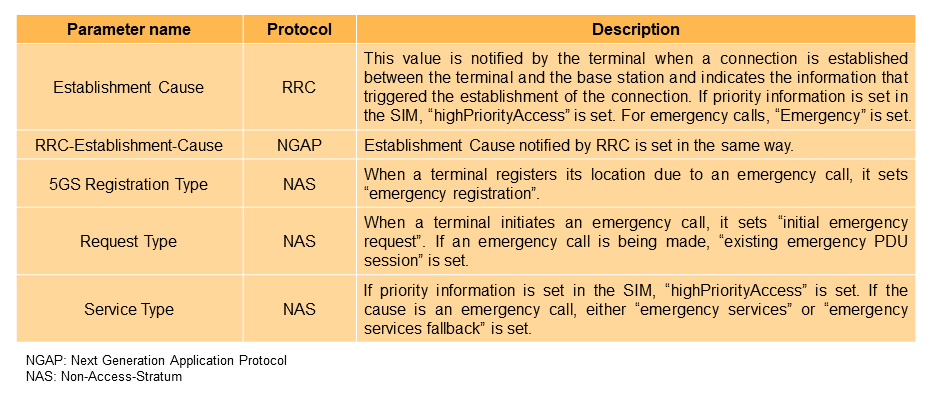
On the other hand, in the case of an emergency call, the gNB is informed by a terminal via setting “emergency” to the Establishment Cause. “Emergency” is a different value from the essential communication indicator. The gNB can control the call as an essential communication or emergency call by referring to the Establishment Cause.
There are two ways for the AMF to determine that the call is an essential communication or an emergency call, depending on whether the radio transmission path establishment process has been performed.
When a call is made and a radio transmission path establishment process is performed, the gNB knows the Establishment Cause from RRC signaling and maps it as Radio Resource Control (RRC)*42-Establishment-Cause and notifies the AMF [7]. By referring to the received RRC-Establishment-Cause as well as the gNB, the AMF can determine that it is an essential communication or an emergency call.
If no radio transmission path establishment process has been performed immediately before, the decision is made by referring to various parameters set in the registration signal, etc. sent by the terminal to the AMF.
2) Determination of Essential Communications in the Core Network
Examples of parameters for determining essential communications circulating in the core network are shown in Table 3. Each NF in 5GC can identify an essential communication in two ways. The first is a method in which an NF that knows that a communication is essential uses a request signal to inform the opposing NF of the suitability of the communication (Fig. 6 Pattern-1). The second method is for the NF itself to query the service that manages the subscription information and emergency session availability to make a determination (Fig. 6 Pattern-2).
(a) Transmission using request signals between NFs
Regarding the first way, there are two main methods of communicating that a communication is essential between NFs. The two methods are notification using the protocol header and notification using the parameters specified in the protocol. The characteristics of MessagePriority for each protocol are shown in Table 4.
GPRS Tunneling Protocol version 2 (GTPv2)*43-C, Packet Forwarding Control Protocol (PFCP)*44, and HyperText Transfer Protocol (HTTP)*45 are considered as cases where protocol headers are used. These protocols specify a field called MessagePriority. For PFCP and GTPv2, the standard specifications are similar and mapping between protocols is easy [8][9]. However, it should be noted that HTTP is treated differently from PFCP and GTPv2-C in terms of the values that can be set in MessagePriority and when not set [10]. For example, when establishing a new PDU session, the AMF sends a request signal by HTTP to the SMF to establish a session, which in turn requests the UPF to establish a session using PFCP [11]. Since there are multiple types of protocols handled in the procedure, consideration must be given to MessagePriority, such as operating in the range of 0 to 15, which can be commonly set for related protocols.
Meanwhile, the method that uses the parameters specified in the protocol without protocol headers basically does not require mapping . As parameters related to essential communications, there are Allocation and Retention Priority (ARP)*46 and mcsPriority, etc., because the range of values they can handle is basically the same for all protocols. However, Table 3 only lists the parameters that can be used to indicate essential communications, and the exact meaning of the parameters needs to be considered. Note that ARP, for example, is a parameter that indicates the priority of resource allocation, so it does not directly indicate essential communications.
When using either protocol headers or protocol parameters, adjustments must be made in accordance with operator policy and vendor product specifications.
(b) Inquiries to services by NFs
The second way, the NF itself queries the service that manages subscription information and session information, can be easily done by taking advantage of the characteristics of the Service Based Interface (SBI)*47. Since SBI adopts a microservice architecture*48 and the services provided by each NF can be used mutually, subscription information can be accessed at any time. This is a 5GC-specific technology that is difficult to achieve with conventional protocol specifications, including EPC. The NF queries Unified Data Management (UDM)*49 to determine if the communication is a call as target of essential communications, and the NF queries AMF/SMF to determine if it is due to an emergency call [12][13]. However, this method requires more interaction than the procedure specified in the standard protocol, and there is a risk of operator-specific processing. Furthermore, this method cannot be used when the UE is camping in LTE, because the UE is connected to EPC and therefore SBI cannot be used.
Evaluation criteria for the first and second ways include two axes: technical difficulty and signal amount. In terms of technical difficulty, technology for the first way is more challenging than that for the second way because it requires agreement on the parameters used to determine essential communications between NFs and consideration of mapping conditions between protocols. On the other hand, in terms of the amount of signals, the second way has the disadvantage in that each NF needs to make a query each time, which increases the processing load required for the query and the amount of signals on the network. Therefore, it is necessary to appropriately select a distribution method for information related to essential communications based on the various characteristics of equipment and application areas of protocols.
4.3 Emergency Call Support
The two main methods of providing emergency calls in 5G SA during the EPSFB method period before the introduction of VoNR are as follows.
- Emergency Services (ES)-FB where the network instructs the EPS transition
- Terminal autonomous EPS transition (N1mode-disable)
In both methods, the emergency call itself is provided in the EPS. The difference between the two is whether the network instructs the terminal to transition to EPS or whether the terminal transitions autonomously when it is in the 5GS. The network informs the terminal at the time of Initial Registration*50 which method is supported by the network. The terminal retains the notified methods while connected to the network, and performs actions according to each method when an emergency call is made [14].
1) ES-FB
ES-FB is the method that instructs a transition to EPS from the network side. This method is used when the emergency call is only provided when in EPS and the caller is in the 5GS. This is described in section 4.13.4 of the 3GPP TS23.502 [3].
An overview of the operation of the ES-FB method is shown in Figure 7. The sequence of the procedure is as follows.
- The terminal requests the AMF to establish an IMS emergency session for an emergency call.
- The AMF requests ES-FB to gNB.
- Perform handover from NR to LTE. If 5GC does not support the establishment of an IMS emergency session, the core network is also switched from 5GC to EPC.
- When the core network is switched to EPC, as in the case of VoLTE, a VoLTE session for emergency calls (IMS emergency session) is established through the coordination of EPS and IMS, and a bearer for voice is activated [15]. If the core network equipment is 5GC, IMS emergency session and QoS flow for voice are established through the coordination of 5GC and IMS.
- Connection made between IMS and PSAP via interconnection with the fixed telephone network.
2) Terminal Autonomous EPS Transition (N1Mode-Disable)
If emergency calls are only provided in EPS and 5GC does not support ES-FB, the terminal will autonomously transition to EPS when initiating an IMS emergency session for an emergency call. At that time, the terminal notifies the network that it has temporarily lost 5G SA capability (N1mode-disabled) [14].
After the EPS transition, the operations from Fig. 7(4) onward are performed. NTT DOCOMO uses this method because of its shorter processing time until the emergency call is set up compared to ES-FB.
- Mission critical: Describes a system that must be able to provide services continuously, and for which interruptions (e.g., due to failures) are unacceptable or could be extremely damaging.
- PSAP: A generic term for emergency agencies that receive emergency calls such as 110, 119 and 911. In Japan, it refers to police and fire departments.
- SIM: An IC card which stores mobile phone subscriber information.
- Procedure: Signal processing procedures implemented between base stations, between base stations and the core network, or between base stations and terminals.
- RRC: Layer 3 protocol that controls radio resources in the radio network.
- GTPv2: A communications protocol for user data transmission which provides functions such as configuring communications paths and data transfer on the core network.
- PFCP: C-Plane protocol used in Sx reference points. SGW-C/PGW-C/SMF instructs SGW-U/PGW-U/UPF how to control packets using PFCP.
- HTTP: A communications protocol used between Web browsers and Web servers to send and receive HyperText Markup Language (HTML) and other content.
- ARP: A parameter indicating the priority of subscribers in the 4G and 5G core networks, ranging from 1 to 15, with smaller numbers indicating higher priority.
- SBI: A unified interface introduced in the 5GC for communications among Network Functions, characterized by the RESTful Application Programming Interface (API) using HTTP/2 as the communications protocol and JavaScript Object Notation (JSON) as the data description language.
- Microservices architecture: A concept that separates the elements that make up an application into smaller units called microservices to increase independence among functions.
- UDM: A database that stores and provides information such as subscription data, location information, and session information in 5GC.
- Registration: In 5G, mobile terminal registration of its current location with the UDM.
-
This article has described technology to provide voice services, ...
Open

This article has described technology to provide voice services, including emergency calls, in 5G SA and improve convenience until 5G SA areas are expanded by using 4G LTE/5G NSA areas, including interworking with EPC and IMS.
We will continue studying technologies related to voice calls with 5G SA, such as VoNR, which enables voice calls using NR, and the application of QoS control to communications other than voice calls.
-
REFERENCES
Open

- [1] I. Tanaka et al.: “CS Fallback Function for Combined LTE and 3G Circuit Switched Services,” NTT DOCOMO Technical Journal, Vol. 11, No. 3, pp. 13–19, Dec. 2009.
 https://www.docomo.ne.jp/english/binary/pdf/corporate/technology/rd/technical_journal/bn/vol11_3/vol11_3_013en.pdf (PDF format:587KB)
https://www.docomo.ne.jp/english/binary/pdf/corporate/technology/rd/technical_journal/bn/vol11_3/vol11_3_013en.pdf (PDF format:587KB) - [2] K. Aoyagi et al.: “5G Advanced Technologies for Creating Industries and Co-creating Solutions,” NTT DOCOMO Technical Journal, Vol. 22, No. 3, pp. 71–89, Jan. 2021.
 https://www.docomo.ne.jp/english/binary/pdf/corporate/technology/rd/technical_journal/bn/vol22_3/vol2_3_008en.pdf (PDF format:0)
https://www.docomo.ne.jp/english/binary/pdf/corporate/technology/rd/technical_journal/bn/vol22_3/vol2_3_008en.pdf (PDF format:0) - [3] 3GPP TS23.502 V15.16.0: “Procedures for the 5G System (5GS),” Jun. 2022.
- [4] 3GPP TS23.228 V15.5.0: “IP Multimedia Subsystem (IMS); Stage 2,” Dec. 2021.
- [5] 3GPP TS29.512 V15.11.0: “5G System; Session Management Policy Control Service; Stage 3,” Jun. 2021.A
- [6] 3GPP TS38.331 V15.18.0: “NR; Radio Resource Control (RRC) protocol specification,” Jun. 2022.
- [7] 3GPP TS38.413 V16.10.0: “NG-RAN; NG Application Protocol (NGAP),” Jun. 2022.
- [8] 3GPP TS29.244 V15.10.0: “Interface between the Control Plane and the User Plane Nodes; Stage 3,” Sep. 2020.
- [9] 3GPP TS29.274 V15.9.0: “Evolved General Packet Radio Service (GPRS) Tunnelling Protocol for Control plane (GTPv2-C); Stage 3,” Sep. 2019.A
- [10] 3GPP TS29.500 V15.7.0: “5G System; Technical Realization of Service Based Architecture; Stage 3,” Sep. 2020.
- [11] 3GPP TS29.502 V15.10.0: “5G System; Session Management Services; Stage 3,” Mar. 2021.A
- [12] 3GPP TS29.503 V15.10.0: “5G System; Unified Data Management Services; Stage 3,” Dec. 2021.A
- [13] 3GPP TS29.518 V15.13.0: “5G System; Access and Mobility Management Services; Stage 3,” Mar. 2022.
- [14] 3GPP TS24.501 V15.7.0: “Non-Access-Stratum (NAS) protocol for 5G System (5GS),” Jun. 2022.
- [15] K. Tokunaga et al.: “VoLTE for Enhancing Voice Services,” NTT DOCOMO Technical Journal, Vol. 16, No. 2, pp. 4–22, Oct. 2014.
 https://www.docomo.ne.jp/english/binary/pdf/corporate/technology/rd/technical_journal/bn/vol16_2/vol16_2_002en.pdf (PDF format:2,110KB)
https://www.docomo.ne.jp/english/binary/pdf/corporate/technology/rd/technical_journal/bn/vol16_2/vol16_2_002en.pdf (PDF format:2,110KB)
- [1] I. Tanaka et al.: “CS Fallback Function for Combined LTE and 3G Circuit Switched Services,” NTT DOCOMO Technical Journal, Vol. 11, No. 3, pp. 13–19, Dec. 2009.

